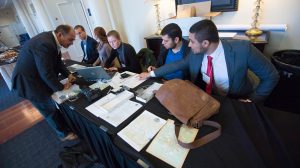
UM engineering students help professor Alexander Yakovlev just before the Advanced Materials conference at The Inn at Ole Miss. Photo by Kevin Bain/Ole Miss Communications
OXFORD, Miss. – More than 100 researchers gathered last week at the University of Mississippi for a two-day conference focused on advanced materials that could transform defense, aerospace and civil environments.
Lecturers included representatives of NASA’s Marshall Space Flight Center, National Science Foundation’s Experimental Program to Stimulate Competitive Research, or EPSCoR, Dynetics, Redstone Arsenal, U.S. Army Engineer Research and Development Center, Institute for Advanced Composites Manufacturing Innovation and the Army Research Laboratory.
The event, held Nov. 16-17 at The Inn at Ole Miss, was co-sponsored by the UM School of Engineering and the Mississippi Research Consortium. The consortium of research universities includes UM, Jackson State University, Mississippi State University and the University of Southern Mississippi.
“The Mississippi Research Consortium was delighted to help sponsor and participate in the Advanced Materials workshop last week,” said Gordon Cannon, vice president for research and T.W. Bennett Professor of Biochemistry at USM, and chair of the consortium.
“It was gratifying to see so many of Mississippi’s university experts gathered to brainstorm ideas for new materials that might be central to a wide range (of) subjects such as energy, air and spacecraft design as well as defense projects. All of these programs have potential to positively impact Mississippi’s economy and job outlook. I would like to thank the University of Mississippi for hosting the event.”
“The purpose of this workshop was to bring forward recent advances in materials science and mechanics in the various sectors and to bridge the gaps between them by increasing awareness of research needs and capabilities in order to create enabling technologies that will have national impact,” said Ahmed Al-Ostaz, UM professor of civil engineering and conference coordinator.
“The goal is to build a bridge from science-based discovery at its highest level to implementation in a number of engineering discipline areas.”
Topics discussed during the meeting included security, resilience and multihazard mitigation; energy; multifunctional materials; multiscale modeling and materials databases; advanced materials, processing and manufacturing; transition from discovery to disposal; and education and workforce development.
In the last few decades, advanced materials research has created a revolution in technological and economic growth in the U.S. and globally. The speed of innovation is hastened by the maturing of nanotechnology that can produce high-performance nanomaterials in large quantities and at low cost.
“Advanced manufacturing and materials will be transformational for our economy and society, and it is exciting to watch these early stages develop,” said Josh Gladden, UM vice chancellor of research and sponsored programs. “As with any transformational change, a great deal of fundamental and applied research is required to move from concept to commercialization.
“We are excited to unlock the research community in Mississippi to engage with these challenges and help push these technologies to the next level.”
Besides representatives from the federal government, national labs and agencies, several UM graduate and undergraduate civil engineering students participated. Those in attendance said that the conference was highly beneficial.
“As these brilliant scientists discussed their projects and the direction that needs to be taken, I realized just how important dialogue is to collaborations for further research,” said Michael Daves, a senior from Fairhope, Alabama.
Conferences such as this are a very efficient way of transferring knowledge between agencies, such as NASA and the Redstone Arsenal, said Dave Stone, lead engineer for the Advanced Composites Lab at the Aviation and Missile Research, Development and Engineering Center at Redstone Arsenal in Huntsville, Alabama.
“It’s not just what we get here, but what we give to the community in application that is important,” Stone said. “The sharing that occurs here links the university professor’s research with practical ramifications for U.S. soldiers on active duty in the desert.
“Transition has to be both timely and affordable, as the Department of Defense has no funds to waste.”
Keynote lecturers during the workshop included Todd May, director of NASA’s Marshall Space Flight Center; Denise Barnes, section head for National Science Foundation EPSCoR; Steve Cook, vice president of corporate development at Dynetics; James Lackey, director of U.S. Army Aviation and Missile Research, Development and Engineering Center at Redstone Arsenal; Stacy Howington, engineer at the U.S. Army Research and Development Center; Lawrence Drzal, director of vehicles technology at the Institute for Advanced Composites Manufacturing Innovation; and Mark VanLandingham, chief of materials and manufacturing for the Science Division at the Army Research Laboratory.
For more information on the Mississippi Research Consortium, go to http://www.mississippiresearch.org/. For more information about the UM School of Engineering, visit http://www.engineering.olemiss.edu.